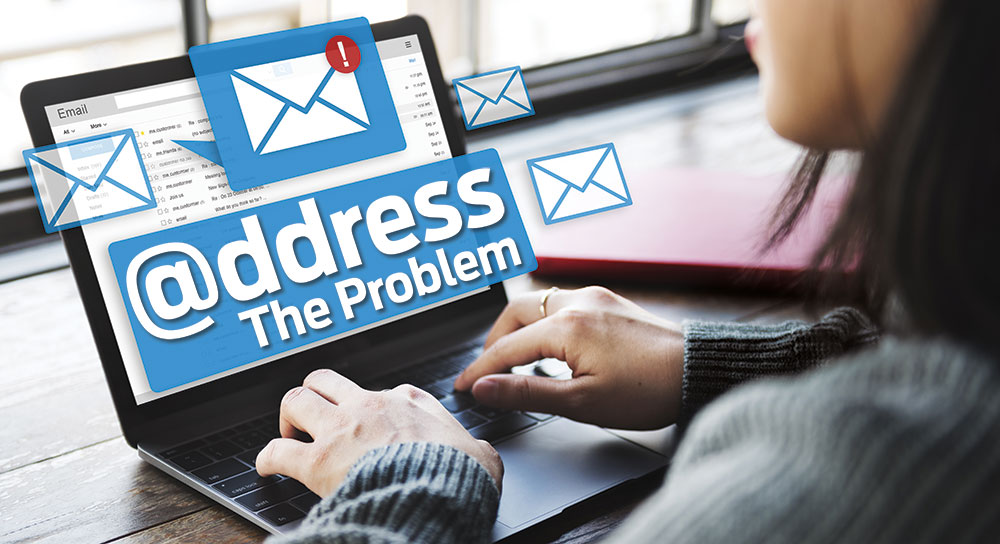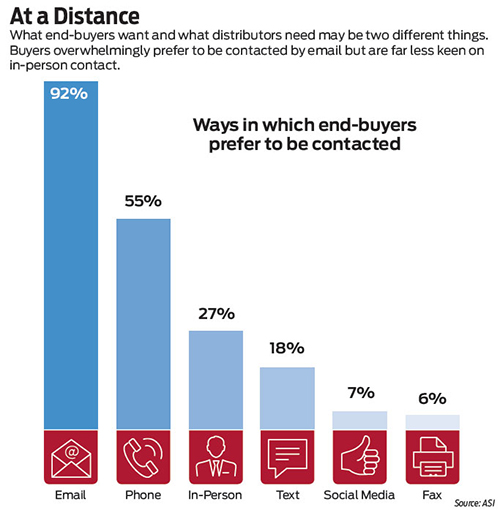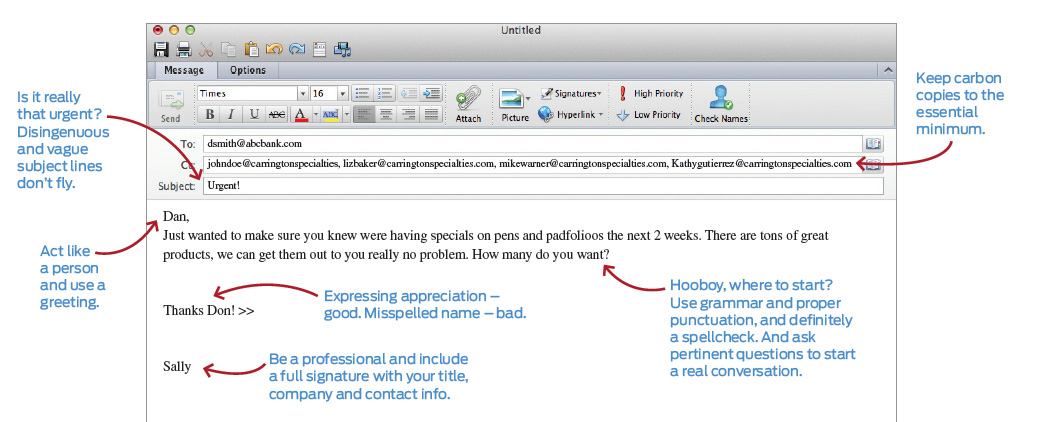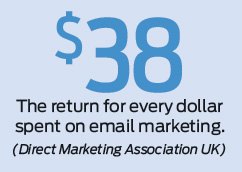March 02, 2018
The Distributor's Guide To Email
You read and send hundreds of emails every day. You’re instantly connected at all hours of the day. You’re an inbox efficiency machine. Has it gone too far?
Mail, fax, email, texting, social media – Mark Eckebrecht has seen it all. The president of Advertech Group (asi/109575) has owned his Ontario-based company for over 30 years and still does a lot of business the old-fashioned way: by word-of-mouth.
>>Don't Miss! Email Best Practices

But that doesn’t mean he totally eschews e-communication, such as email and social media. On the contrary, email especially still takes up a significant part of Eckebrecht’s day. (And as this writer can attest, he’s very quick to respond. His average response time: a brisk 10 minutes.) In fact, if he doesn’t keep up with it over the weekend, he’ll often have 500 to 700 new messages in his inbox when he comes in Monday morning. “It takes a half-hour to organize everything,” he says. “And then I have to go through the Junk folder in case anything was sent there.”
It’s a complaint heard around the world. The average office worker in America receives 121 emails a day, according to Templafy, and a recent study by Adobe found that employees spend an average of 4.1 hours a day checking work email. That’s over 1,000 hours each year.
And although email’s demise has been predicted countless times over the past several years, it has staying power, as evidenced by billions of active, cluttered inboxes. Templafy estimates that there are more than 3.7 billion email users worldwide, and that the number of emails sent has grown from 205 billion a day in 2015 to 269 billion in 2017, an increase of 31%.
In other words, a very significant amount of our communication occurs through email. And promotional products buyers like it that way. In fact, a recent ASI survey of end-buyers found that 92% of them prefer to communicate with distributors by email. (Phone was the next highest at 55%.)
Such results are not limited to the promo industry; a recent MarketingSherpa study of more than 2,000 American adults found that 72% prefer email when it comes to communication with companies.
Despite his preference for the old ways of generating sales, Eckebrecht estimates that about 95% of his company’s interaction with clients is over email. It has convenient features, he says, like the capability to instantly communicate product ideas to multiple customers. “When I’m at a trade show and I’m looking for ideas for clients, email is a great way to get those to them,” he says. “You can put all the information in one email and blast it to your list.”
>>Expert Advice! 5 Email Marketing Tips
But at the same time, Eckebrecht recognizes that email isn’t the best tool for communicating complicated orders and steps to problem resolution. Nor does he feel that it’s meant for true relationship building, especially in this era where buying is more dehumanized than ever. “Email is efficient, but not personable,” says Eckebrecht. “I’d rather use the phone most of the time. It’s next to impossible now to get someone on the phone, and with voicemail, forget it. But newer technology isn’t going away.”
That’s the crux of the situation. Email makes communication so seamless and effective, it’s no wonder the entire business world has become completely engulfed in it. Yet it’s not without faults that, in the long run, can be a conspicuous drag on your sales. However, by finding a proper balance, distributors can still be efficient while establishing the personal contact they need. And in doing so, they can break their email addiction.
 den McClellan, president and COO of Icon Blue Inc. (asi/229398), estimates that 90% of her employees’ interaction with clients is conducted over email. Even though sales reps at the Los Angeles-based distributor make a conscious effort to have employees set aside face-to-face time, the reality is that most clients choose email when it comes to contacting her company.
den McClellan, president and COO of Icon Blue Inc. (asi/229398), estimates that 90% of her employees’ interaction with clients is conducted over email. Even though sales reps at the Los Angeles-based distributor make a conscious effort to have employees set aside face-to-face time, the reality is that most clients choose email when it comes to contacting her company.
“Most of them prefer email because it’s very efficient,” McClellan says. “Wherever you are, you can see what’s going on and respond. I remember a time when everything was done over the phone, so you had to leave detailed messages. But with email, the message is delivered instantly and you can attach extra information. You can reach so many people, and you have a written record of data. In this industry, we rely on that. But we make it a point to have verbal communication with them as well.”
Having that written record is crucial, and explains in part why, despite the growth of texting and social media, email still reigns supreme. “Conversations are well documented, so it’s easy to go back and confirm,” says Ann Baiden, president of Innovatex Solutions Inc. (asi/231194). “When you’re sending proofs and quotes I don’t know of a better method. Social media may begin the conversation, but email maintains it.”
That goes for both distributor and client, who can easily keep track of order statuses over email, usually on their mobile device. That written record of sale came in handy for Boost Promotions (asi/142942) when, after a large order of lanyards was delivered, the client asked why there were no badge holders. “We were able to trace back their emails and show them they never asked for those,” says CEO Christopher Faris. “So email creates a paper trail. However, phone calls let you guide the conversation and add a human element. Email is not the most effective method for that.”
For account and order management, email is clearly an effective tool. But it’s not without its downsides. Laboring through unnecessary marketing messages (sometimes hundreds at a time), responding to customer requests and queries, and managing the sales process for various accounts all take up a significant portion of the day.
“When I started in the industry, you had an empty inbox at the end of the day because there wasn’t as much coming in and you were able to address things more quickly,” says Baiden. “Now we get masses and masses of emails, and we don’t answer and execute right away anymore.” The Richmond Hill, ON-based distributor recently read Email Warrior: How to Clear Your Inbox and Keep It That Way by Ann Gomez, and was struck by the book’s ideas to not open an email until you have time to address it. “It’s a different strategy than ‘reply immediately,’” Baiden adds.
And then there’s the email-enabled smartphones and other handheld devices, which allow reps to be anywhere and still be accessible. It’s amazingly effective for staying on top of client requests and pressing matters, but “we’re always in a hurry, we have busy schedules, and we’re so involved because of the ease of communication,” McClellan says. “It can lead to burnout.”
 ever has it been more tempting to solely rely on email when communicating with prospects and clients. But distributors feel that temptation pulls sales reps in too deep. “We’ve gotten too comfortable with email,” says Faris. “You need the human element and you need to build the relationship, because we all sell the same stuff. If they’re buying a mug, they can go anywhere for that.”
ever has it been more tempting to solely rely on email when communicating with prospects and clients. But distributors feel that temptation pulls sales reps in too deep. “We’ve gotten too comfortable with email,” says Faris. “You need the human element and you need to build the relationship, because we all sell the same stuff. If they’re buying a mug, they can go anywhere for that.”
At Total Marketing (asi/345675), email is a way both to communicate one-on-one with current clients and guide new customers through email marketing, but personal contact is still a priority. “We emphasize one-to-one contact, whether it’s over the phone or in person,” says Ali Weitzman, vice president of marketing. “There’s so much competition, that personal touch makes a difference. Email can be used for follow-up so everyone has the same understanding, but we push phone and face-to-face as much as we can.”
Screenbroidery/Rectorcom (asi/305623) practices many of the same principals – using email for sales orders, proofs and following up on order statuses but also preaching the importance of hand-delivering items to customers at least once a quarter. “The more clients see you,” says Mark Myers, chief sales officer, “the more they’ll order from you.”
Weitzman calls it “door-knocking time,” though some employees are apprehensive. “Younger hires don’t always want to do it, but we take them on the road,” she says. “When you go visit customers, they’re more likely to trust you when it comes to a complicated order. They’ll be more comfortable with a sales rep who has offered the personal touch from the beginning. You learn what’s important to clients and you get a better idea of how they want to market to customers.”

If face-to-face meetings aren’t always viable, whether because of distance or client preference, at least counter-balance email with phone calls. “We’ll send ideas to clients through email, where we’ll ask to schedule a follow-up call to go over them in more detail,” says Kimble Bosworth, president and CEO of Proforma Printelligence (asi/491390). “There can be confusion in emails, and calls avoid some of that.”
While it’s the reality of the world today, it also means even in everyday interactions with others, the human element is lost, says Eckebrecht. “It can get a little out of control,” he says. “All the time now, I see people on their phones when they’re out to dinner and they’re not talking to each other. As a company, we have to be present both face-to-face and on social media. It’s not going to change.”
While being accessible practically 24/7 over email is key to doing business in this day and age, forging lasting ties with clients is more than just the ability to send messages back and forth. “There are two parts to a client relationship,” says Baiden. “At first, you need more of the human touch. Then, when there’s an established relationship, you can use more email, but you still need be proactive about building relationships, face-to-face and voice-to-voice. It’s important not to get caught at your desk.”
Don't Do It!
How not to send emails to your clients and prospects.

Click here for a larger image of the above.
Made for Marketing
In the digital world, email marketing checks all the right (in)boxes.
In the almost 50 years since the first message was sent between two computers by programmer Ray Tomlinson, email has evolved from a novelty to an imperative business tool. And the rules of engagement have changed accordingly.
In the early to mid-1990s when email was new, it was akin to the Wild West, says Ken Mahar, founder & CEO of email marketing agency Email Broadcast in San Luis Obispo, CA. “When I started this company in 2000, there was no such thing as ‘unsubscribe’ or CAN-SPAM,” he says. “Deliverability was 100%, because there were no protocols yet. So people were blind-carbon-copying 500 people at a time and sending them junk. It was ripe for abuse.”

With the suppression of spam by both governments and email providers, companies were compelled to reevaluate how they communicate with prospects and clients, if they wanted to do it effectively. “Now, businesses are doing it smartly,” says Sherman Standberry, managing partner & CFO at LYFE Marketing, an email marketing agency in Atlanta. “They’re sending better emails to their database, sometimes personalized based on the pages they’ve viewed at the company’s website. It’s much more advanced.”
In part because of that, email is highly effective at reaching target audiences, despite the popularity of social media marketing in recent years. “People were pushing their pages on Facebook, but then Facebook became pay-to-play and organic reach went down dramatically,” Standberry explains. “Email isn’t as trendy as social media, but it’s very effective. You can see 20%-30% open rates on emails. That’s gold. Social media doesn’t do that. You have to buy ads.”
So why does a well-crafted email have more reach than a Facebook post? Mainly because it goes straight to people’s inboxes, which they’re checking constantly. “While people are using it, they’re ready to click, getting things done, processing and making decisions,” says Mahar. “Offer them information and solve their problems. Its demise has been predicted many times, by texting, Facebook and Snapchat. But it’s like the equivalent of a Swiss Army knife; it does so much.”
Sara Lavenduski is the senior editor for Advantages. Tweet: @SaraLav_ASI. Contact: slavenduski@asicentral.com